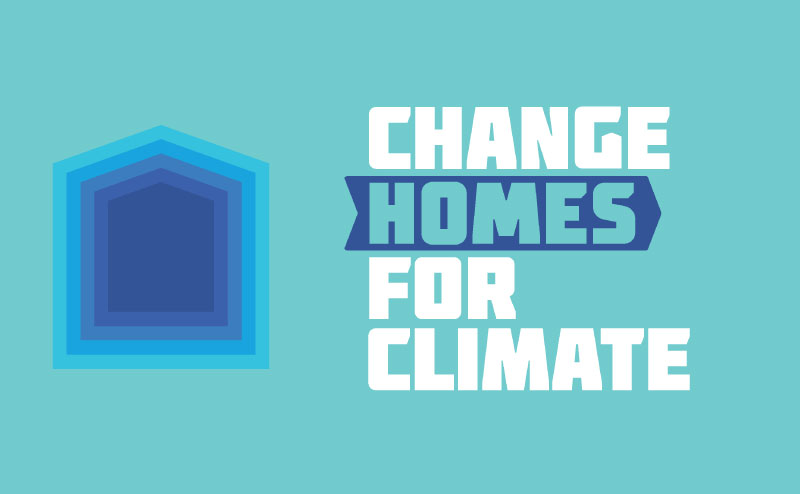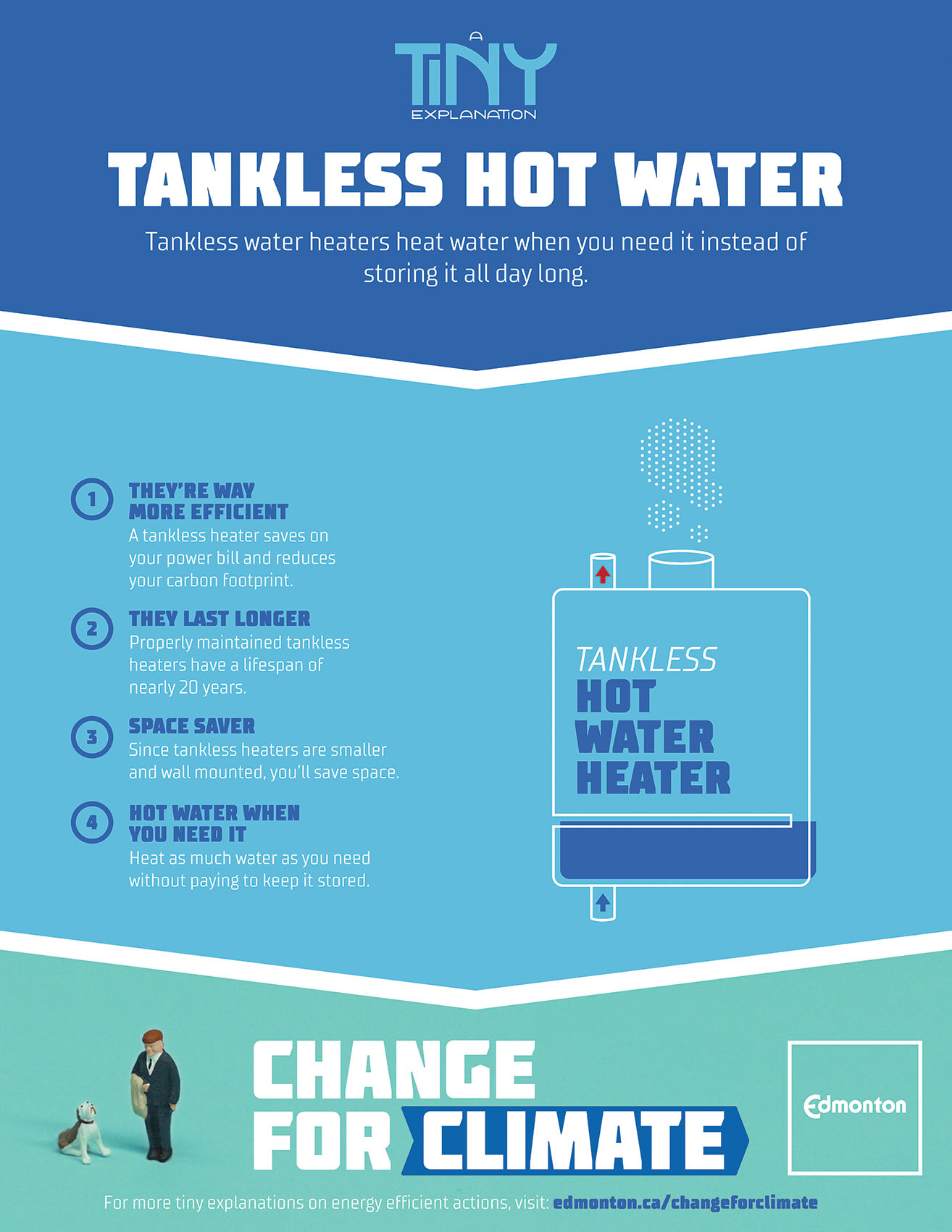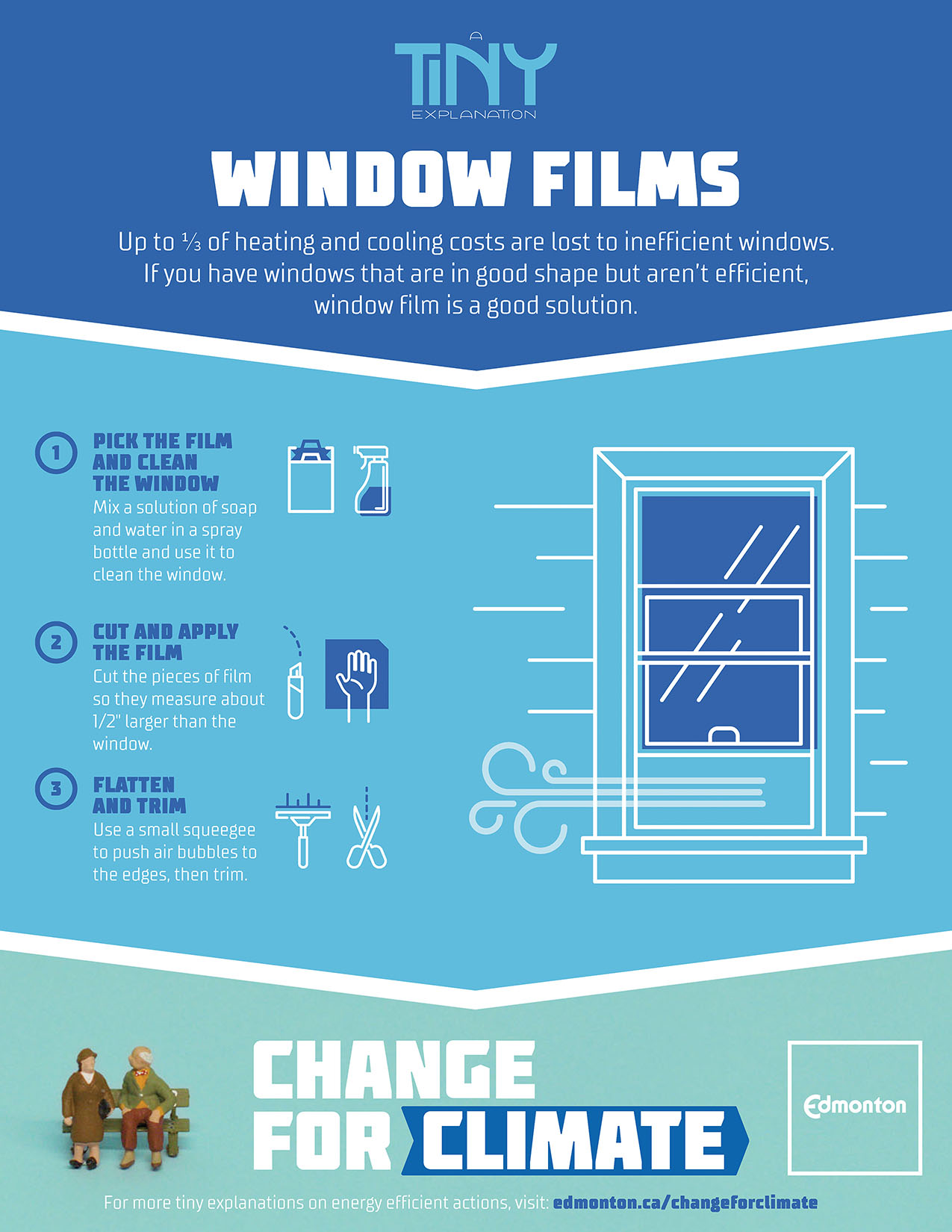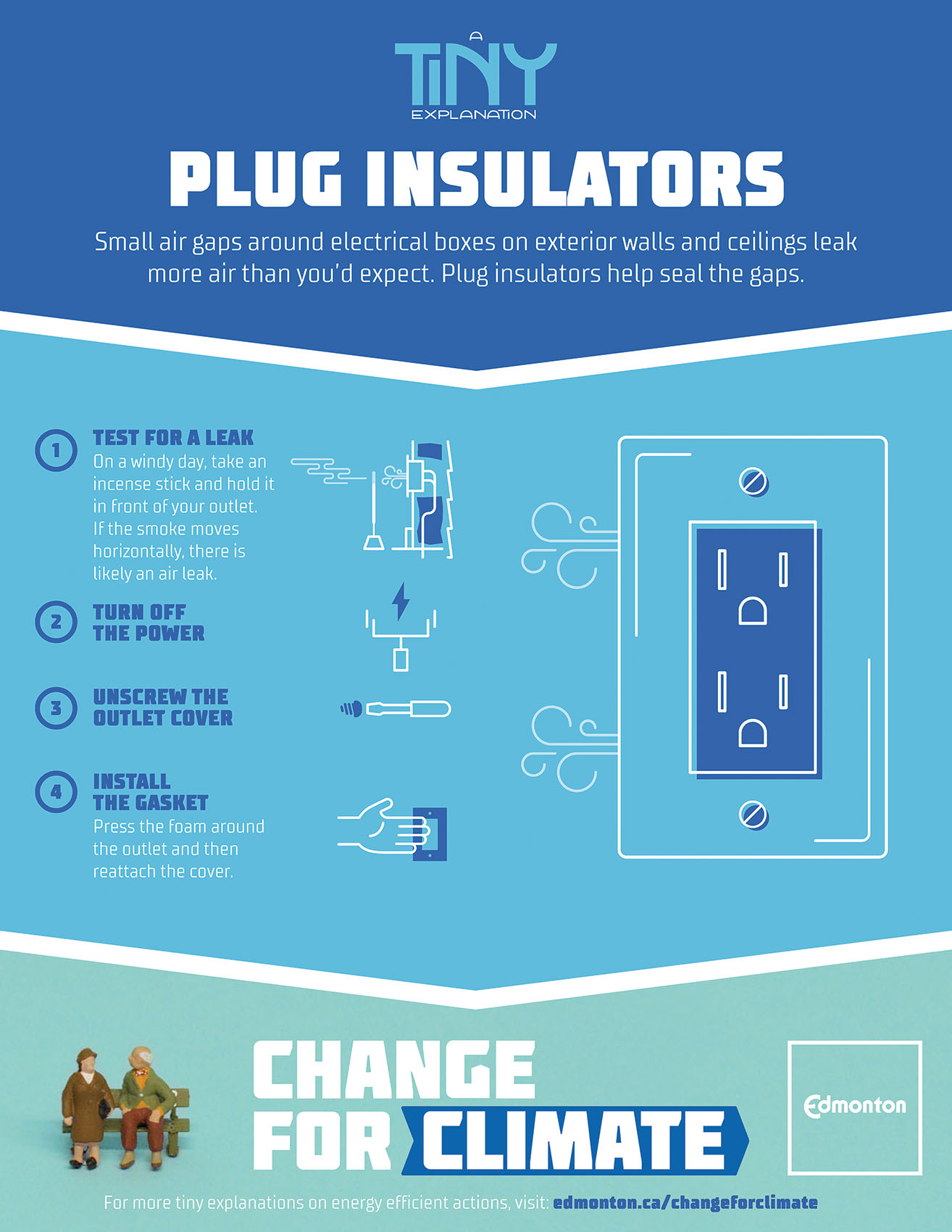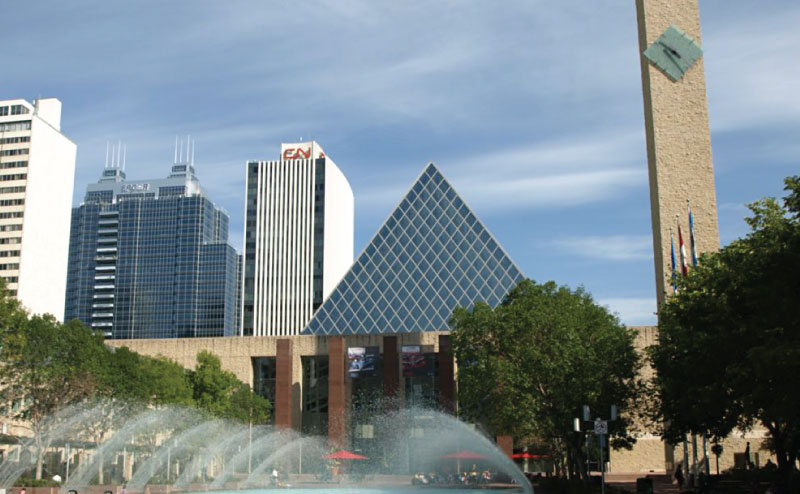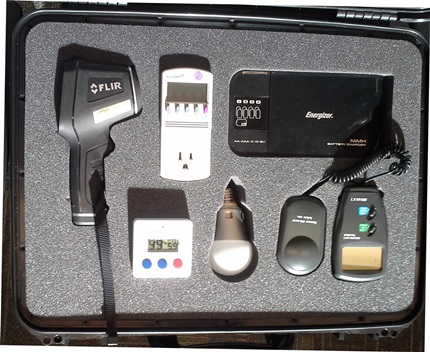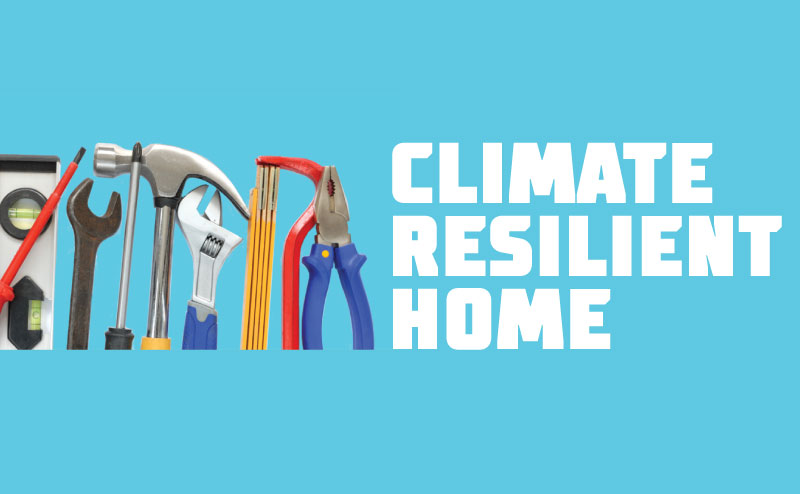The Home’s Magic Membrane
The building envelope is the physical separator – the walls, roof and foundation – between the inside and outside of the building. The design, configuration and performance of the building envelope have a direct impact on your comfort, home heating bill and home maintenance costs. The envelope is also the longest-lasting and most difficult piece of a home to change, so it should be a top priority when building.
Energy-Efficiency in New Homes
- Insulation: Proper insulation keeps heat inside when it’s cold outside, and keeps it cool inside when it’s warm outside
- Good Windows: Energy-efficient windows, doors and skylights can reduce your home energy costs
- Ventilation: Highly efficient and airtight homes will typically have a heat recovery ventilator (HRV) that provides abundant fresh air into the home while minimizing heat loss
- Air Leaks: Airtightness (sealing) is critical to reduce leakage of air between indoors and out, this includes things like caulking and weatherstripping in existing homes
Did You Know?
A high-performance, energy-efficient building envelope can significantly reduce your home heating costs.
Building to Code Achieves the Following Effective R-values (RSI):
Building better will achieve higher energy efficiency
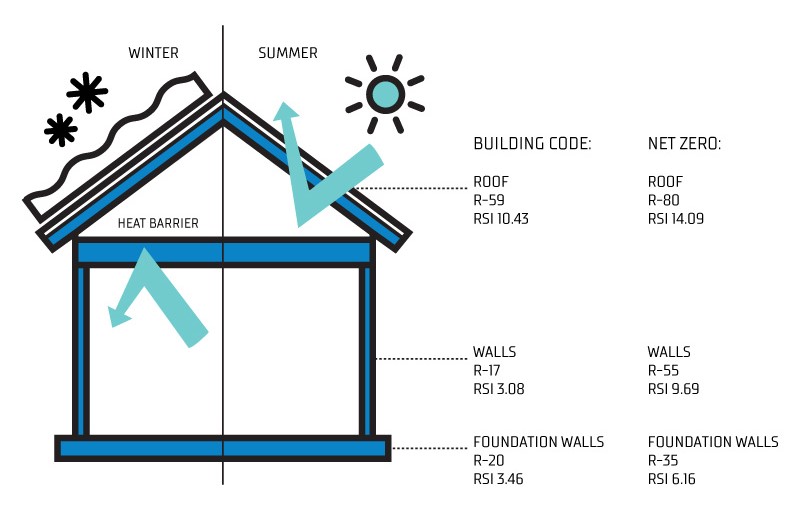
What is EnerGuide?
EnerGuide is Canada’s energy rating and labelling system that certifies the energy efficiency of new and existing products and homes. The EnerGuide rating allows you to easily compare the energy efficiency of major household appliances sold in Canada. EnerGuide also provides a standard measure of your home’s energy performance.
How Does Your Home’s Energy Performance Stack Up?
The EnerGuide label shows you (and future buyers) exactly how energy-efficient your home is and allows you to compare against similar homes in your neighbourhood and across Canada. If you’re planning to renovate or sell your home, the rating shows your home’s present level of energy efficiency AND projects the level it could achieve with recommended upgrades.
What the Numbers Mean
As of 2016, the EnerGuide rating system has changed. The new EnerGuide labels show the gigajoules (GJ) per year that a house uses.
GJs per year is a unit of measurement for energy on an annual basis. The higher the GJ per year number, the less efficient the home is. The closer to zero the GJ per year measurement is, the more efficient the house is. Homes that produce more energy than they use will have a rating of zero.
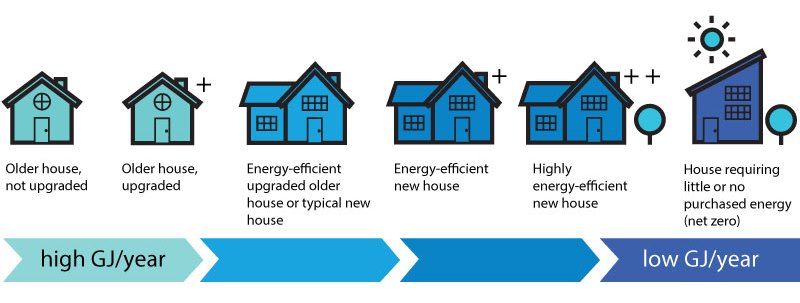
Home Energy Labelling Program
The City of Edmonton has a home energy labelling program called Home Energy Plan.
On June 20, 2012, Edmonton City Council supported the development of a New and Existing Home Energy Labelling program, as outlined in the Green Building Plan.
Get To Know The Green Rating Systems
Rating systems play an important role in promoting green homes. Some, like EnerGuide and Passive House, focus on energy performance. Others such as R-2000, BuiltGreen and LEED consider a wider set of green criteria important to Edmontonians, such as indoor health and local materials. A green building certification provides assurance that the home’s green claims have been verified.
BuiltGreen
BuiltGreen is a popular green building rating system that applies to houses, row houses, and condominiums. It includes an energy efficiency requirement and optional categories from which the builder can select.
LEED
Leadership in Energy and Environmental Design (LEED) is a green building rating system that provides a rating (certified silver, gold, or platinum) of the building’s overall performance.
Passive House
Passive House is a rigorous certification system with the goal of producing homes that use almost no energy. Passive Houses must meet very stringent requirements regarding both their design and construction.
R-2000
R-2000 includes requirements related to energy efficiency, indoor air quality, and the use of environmentally responsible products and materials.
ENERGY STAR for New Homes
The ENERGY STAR for New Homes initiative promotes energy efficiency guidelines that enable new homes to be more energy-efficient than those built to minimum provincial building codes. Home builders must be licensed for ENERGY STAR for New Homes.
Did You Know?
According to a study by the UCLA Institute for the Environment and Sustainability, green certification can add an average of 9% to the resale value of buildings.
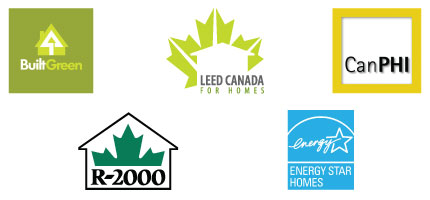
Healthy Indoor Spaces are Important for Edmontonians
Edmontonians spend a great deal of time indoors, particularly in winter, so it’s important to make our indoor spaces as healthy as possible. A healthy home is free of toxins, provides plenty of fresh air and lets lots of daylight in.
Healthier product and material choices can reduce the toxins that potentially accumulate in your indoor environment, cut down on odours and provide a more pleasant living space that can enhance the value of your home.
What To Look For
Homes On Resale Market
Depending on the age of the home, some potentially toxic compounds may have been used in its construction like lead paint, asbestos and urea formaldehyde foam insulation.
It can be difficult to identify the presence of these substances without hiring an expert. If it’s known by the seller, it must be disclosed at the time of sale.
New Homes
- Look for low-volatile organic compounds(VOC) paints, adhesives and flooring (Green Seal, Green Label or equivalent labels)
- Look for rapidly renewable or recycled materials like bamboo flooring or recycled glass tile
- Ask if the wood (including bamboo) is certified by the Forest Stewardship Council (FSC), which means it comes from sustainably managed forests
Low Volatile Organic Compounds (VOC)
- Healthy homes use low-VOC paints, glues and flooring materials, with eco-labels such as Green Seal or Green Label for flooring
- VOCs are in many things and the products brought into the home after you move in can also contribute to indoor air-quality issues
Ventilation
A well-sealed healthy home has an efficient ventilation system such as a heat recovery ventilator.
Natural Lighting
Look for healthy amounts of natural lighting in all areas that are regularly occupied.
Did You Know?
A number of organizations offer product certification programs. When choosing products or materials, always look for eco-labels such as Forest Stewardship Council (FSC) certified lumber and Green Seal paints.
Your Kitchen
The average kitchen accounts for up to 14% of a home’s total energy bill.
If your refrigerator and dishwasher are more than 10 years old, you can most likely reduce your utility bills by replacing these appliances with high-efficiency models. There’s an initial investment to upgrade old appliances, but chances are you’ll appreciate the superior performance and lower utility bills.
Look For The Labels
The EnerGuide label shows the total annual energy the appliance will consume yearly under average operation. You can use the rating to compare your options for electrical appliances.
An ENERGY STAR label means that a product meets stringent energy requirements. Ovens and ranges aren’t included in the program, given the inherent inefficiency of these appliances.
Best Appliance Size
Refrigerator models with the freezer on bottom use up to 12% less energy and models with the freezer on the top use up to 40% less energy than comparable side-by-side refrigerator/freezer models.
Compact dishwashers use less water and energy per wash, but if you have to use it more than once a day, it’s likely more efficient to use a standard size. Like refrigerators, dishwashers operate most efficiently when full.
You shouldn’t position your dishwasher next to the refrigerator. The heat produced by the dishwasher causes your refrigerator to work harder.
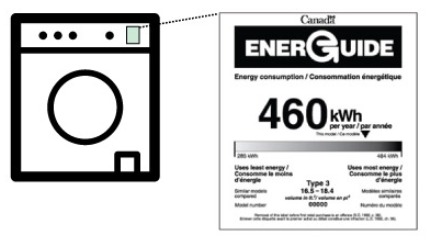
Your Home’s Biggest Energy User
On average, home heating accounts for about 2/3 of your home’s energy use, so making the right choice in a heating system is important. Most homes in Edmonton are heated using a forced-air furnace in which natural gas combustion heats the air, which is then blown throughout the home via a network of ducts and vents.
EnerGuide and ENERGY STAR
For all gas-heating appliances, look for the EnerGuide or ENERGY STAR label (or both) to determine the energy efficiency of the appliance. Efficiency is measured by Annual Fuel Utilization Efficiency (AFUE). An AFUE of 90% means that 90% of the energy in the fuel becomes heat for the home and the other 10% escapes up the chimney and elsewhere. Look for an efficiency above 95% as best practice.
Condensing Furnaces and Boilers
Condensing furnaces or Boilers condense the water vapour produced in the combustion process and use the heat from this condensation. New furnaces have an AFUE of 90% or better, but a lot of old ones are still in operation. The cost of a new furnace for an average home can usually be recouped in energy savings in less than 10 years.
Did You Know?
Use a programmable thermostat to drop the temperature by 1oC over an eight-hour period to save about 2% on your heating energy consumption. Replace an 85% efficiency furnace with a 92% efficiency furnace to reduce your heating costs by 7%.
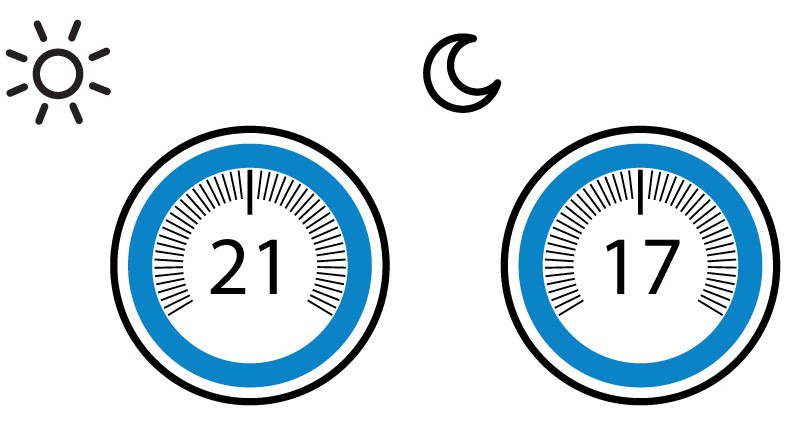
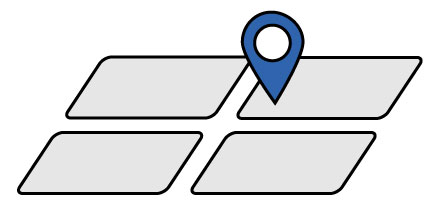
Location Matters
Your location plays a big part in determining how reliant you are on your personal vehicle—which is a major factor in your ability to make more sustainable travel choices (transit, walking) that reduce emissions and help mitigate climate change.
A walkable community, in particular, can be a very smart choice for reducing transportation expenses, minimizing your carbon footprint and promoting an active lifestyle that contributes to better health.
Leveraging Location
When evaluating a location, consider proximity to:
- Work – Can you avoid driving to and from work?
- Transit – Are you within a 5-minute walk of a regular bus stop or a 10-minute walk of a rapid bus or rail?
- Amenities – Do you have quick and easy access to services, groceries, restaurants and shopping?
- Parks and Greenspace – Are there nearby walking trails, dog parks or sports fields?
Did You Know?
Every address in Edmonton has a Walk Score and is sometimes included on MLS listings.
A “Right-Sized” Home
When it comes to homes, bigger isn’t necessarily better. Choosing a home that meets but doesn’t exceed your family’s needs can save you money on your monthly heating and electricity bills—and helps Edmonton meet its goals of using less fossil fuel and reducing greenhouse gases.
As a rule, a smaller home uses less energy than a larger one of a similar age. Plus, in addition to being more cost-effective and energy-efficient, a smaller home is also easier to clean and cheaper to remodel.
Home Size Quick Math: 500 Square Feet per Person
Depending on your family’s needs, aim for 500 square feet of living space per person. To maximize space, look for homes with an open plan or that can be easily renovated to create an open plan in the main living areas.
Did You Know?
Some things are better together. Attached homes like duplexes, townhouses and apartments use less energy on a square-footage basis than single-detached homes.
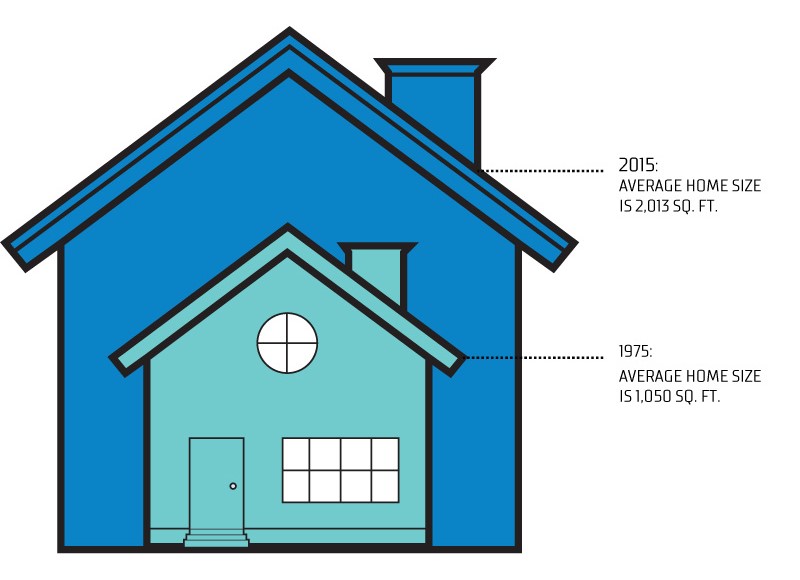
Your Home’s Second Biggest Energy User
On average, water heating accounts for about 20% of the total energy consumed in a home and is the second largest energy user after space heating. Luckily, it’s one of the most straightforward elements to upgrade and provides a good opportunity for energy savings.
Storage or Tankless?
Natural Gas Storage Water Heaters
Natural gas storage water heaters have cylindrical tanks with a ready supply of hot water. Since water is constantly heated in the tank, energy can be wasted when it isn’t in use.
Choosing an appropriately sized tank minimizes this standby heat loss. For example, a family of four with two bathrooms, a dishwasher and a clothes washer requires a 180-litre (40-gallon) tank.
Tankless Water Heaters
Tankless water heaters, also known as on-demand or instantaneous water heaters, provide hot water only as needed, eliminating the standby heating losses associated with storage tank systems. On-demand water heaters can be between 19-53% more energy-efficient than conventional systems.
The greatest potential improvements are in homes that use the least hot water, such as small dwellings and places with very efficient fixtures.
Though the initial cost is higher, wall-mounted tankless water heaters take up less space, typically last longer and have lower energy costs. To determine if this is appropriate for your home, work with an experienced mechanical professional to calculate the payback.
Drain-Water Heat Recovery
These systems can capture up to 60% of the waste heat that passes through drains. The heat that’s recovered is returned to the system which lessens the amount of energy required to heat additional hot water.
Did You Know?
Most tankless water heaters have a life expectancy of more than 20 years. They also have easily replaceable parts that extend their life by many more years. In contrast, storage tank water heaters last 10 to 15 years.
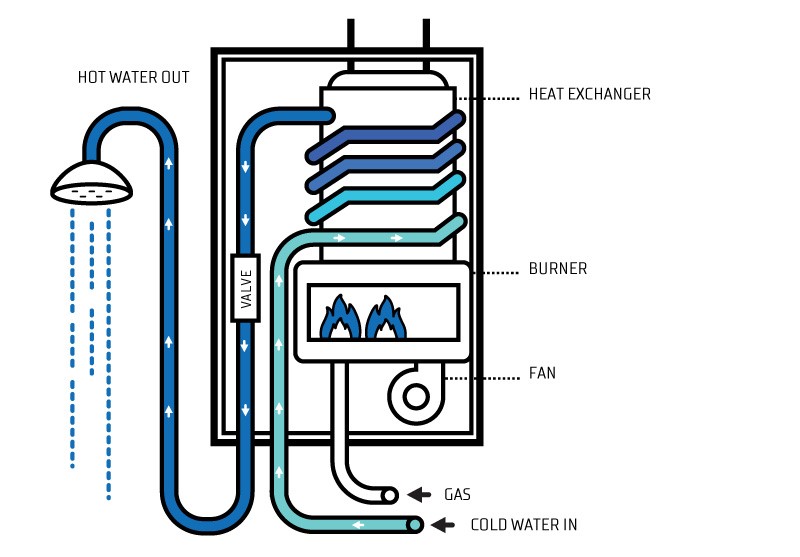
Eco-Landscaping Makes Sense
Eco-friendly landscaping offers a wide range of landscape design possibilities that can help your home look great while minimizing chemical fertilizers, reducing water consumption and saving money. Lawns and gardens also provide valuable green space and help increase infiltration and decrease the flow of water off your lot. This reduces the demands on the storm sewer system and can decrease contaminants entering the North Saskatchewan River.
Lawns
- Lawns only need 2.5 centimetres (1 inch) of water per week to stay nice and green
Native Plants
- Choose plants that thrive in Edmonton’s local climate
- Choose native plants suitable for landscaping
Trees
- A well-placed line of evergreens on the north and west side of your home provides shelter against winter winds and reduces your home’s demand for heat
- Deciduous trees (trees that lose their leaves) on the south side of your house provide shade in the summer, and sunshine during winter
Soil, Mulch and Compost
- Provide a minimum of 15 centimetres (6 inches) of soil for lawn areas and 30 to 45 centimetres (12 to 18 inches) for shrubs
- Soil should be good quality, contain organic material such as compost and drain well
- Mulching in the spring reduces weeds and the need to water
- Mulching in the fall protects plants against winter
- Use a composting bin to make natural fertilizer and soil conditioner out of household and yard scraps
Irrigation and Rainwater
- Ensure that irrigation systems use drip or low-volume nozzles wherever possible
- Automatic shut-off devices or times are also recommended
- Capture and store rainwater in a cistern or barrel to irrigate your garden
Did You Know?
Eco-landscaping approaches to your home’s lawn and garden reduce energy use while improving the aesthetic and property value of your home.
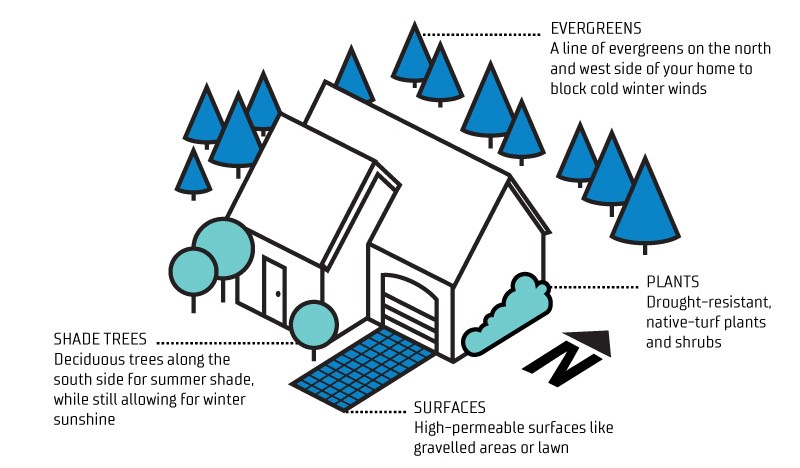
Clean Energy With A Low Carbon Footprint
Solar energy works in any climate and the fuel – sunshine – is free! Installing renewable energy systems helps reduce Edmonton’s reliance on fossil fuels, which contributes to Edmonton’s climate change mitigation goals. Even the generation of small amounts of power at the household or building level makes Edmonton’s energy system more resilient and helps create green jobs in the city.
Go Solar
- Consider what type of system you want: water heating or photovoltaic (electricity-producing)
- Work with a qualified system designer to select the appropriate technology and system size for your home CanSIA (the Canadian Solar Industries Association) provides guidance on selecting qualified solar energy service providers
- Make sure your house is as energy-efficient as possible before adding solar
- If buying a newer home, look for a solar-ready house, which has had simple provisions made for adding solar panels such as roof space, utility room space and a pipe chase to connect the roof and utility room
- Also consider passive solar design features to reduce heating energy demand by 25% or more in a well-designed, high-performance passive solar home
Did You Know?
Using solar panels means you’ll be less affected by fluctuations and long-term increases in the price of conventional energy. Solar panels can supply anywhere from a few percent up to 100% of your electricity and hot water needs.
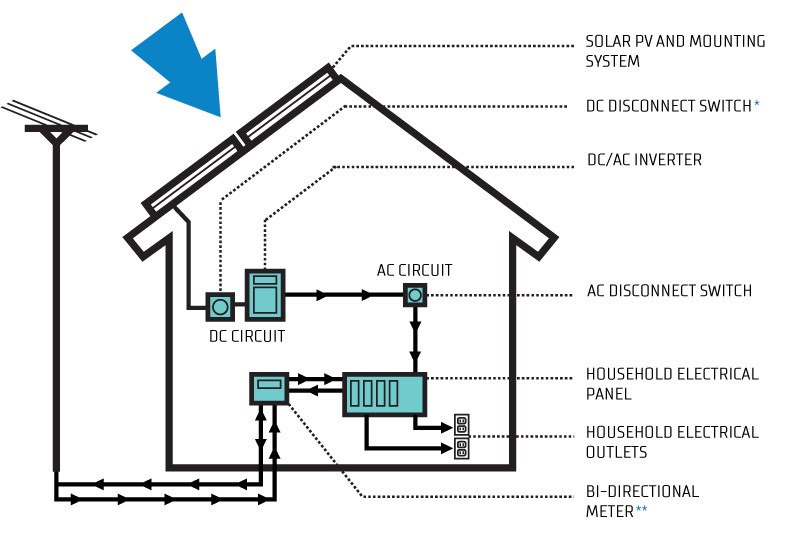
* The DC Disconnect Switch allows for the system to be shut down for maintenance or in the event of a house fire.
** The Net Meter measures power coming from the grid and power that the house is exporting to the grid.
*** The PV Generation Meter keeps track of how much power the PC system is generating.
A Breath Of Fresh Air
Because we may spend up to 90% of our time indoors, fresh air is extremely important. Ventilation provides an abundance of fresh air and helps control moisture, which minimizes mould growth and structural damage.
A Well-Ventilated Home
In older homes, strategically placed windows allow for cross-ventilation to cool as much of the home as possible when windows are open. There should also be exhaust fans in all bathrooms, and in the kitchen to prevent moisture buildup. In newer homes, mechanical ventilation systems allow for fresh air intake. In high-performance, tightly sealed new homes, a heat recovery ventilator (HRV) delivers fresh air, extracts stale/high-moisture air and recovers 60 to 90% of heat from the exiting air, saving both energy and money.
Did You Know?
An HRV improves indoor air quality, reduces household odours, helps overcome moisture-related health and structural problems and reduces heating costs.

Water Conservation = Cost Conservation
Simple, low-cost water conserving fixtures can reduce your water consumption and water bills significantly. By switching to energy-efficient and water-wise low-flow fixtures and appliances, the average Edmonton homeowner could save hundreds of dollars per year.
Be Water Wise
What to Look for in Household Products
Low-flush toilets use about 4.8 litres per flush, compared to older models that use between 13 to 20 litres per flush. Dual-flush toilets are even more efficient, at 3 to 6 litres per flush.
Low-flow showerheads and faucets, showering is one of the most significant water uses in our homes. Low-flow showerheads (under 7.6 litres per minute) and low-flow bathroom faucets (under 5.7 litres per minute) are readily available for a cost comparable to traditional high-flow fixtures. Using an aerator means you can upgrade existing fixtures and achieve savings by only spending a few dollars.
Kitchen fixtures and appliances, using low-flow faucets and accessories and an ENERGY STAR dishwasher, avoiding the heat-dry setting and avoiding using the in-sink garburator can also reduce your water and energy consumption.
Washing machines, using ENERGY STAR high-efficiency (HE) clothes washers, washing in cold water, conducting routine maintenance on machines and using clothes lines and drying racks instead of electric dryers can all help to reduce your energy bills.
Did You Know?
Leaks account for about 14% of water use in the average household. That's a lot of water (and money) literally going down the drain! Learn more about finding and fixing leaks.
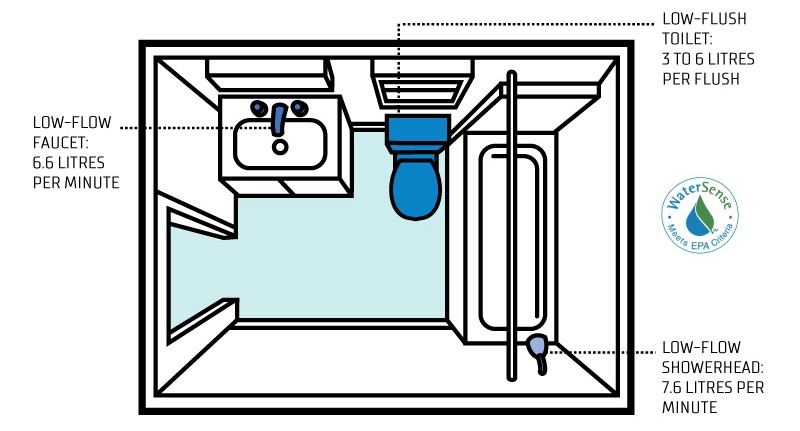
Getting Greener Every Day
There are many other emerging technologies that have potential green benefits but are not yet commonplace:
Geoexchange, Geothermal, or Ground-Source Heat Pumps
Geothermal heating and cooling systems use buried pipes to take advantage of the stable earth temperature below the frost line. Rather than create heat, these systems move heat as needed using a heat pump and as a result, are more efficient than traditional systems. When paired with green power, carbon emissions can be eliminated entirely.
Wind Energy
While large-scale wind energy generation sites are growing, small systems for homes tend to have relatively high costs compared to other options. It’s also worth noting that the winds that Edmonton experiences are often intermittent and too variable in speed to generate significant quantities of electricity. As a result, it can be challenging to design a system to generate dependable power at the household level.
Combined Heat and Power (CHP) or Cogeneration
This system uses a fuel fired engine to generate power while simultaneously capturing the excess heat produced for heating purposes. Using the waste heat and creating electricity on-site makes the system more efficient. However, these systems can require a lot of maintenance and are best suited for buildings which have a constant need for heat so that the excess heat is not wasted.
District Energy
A district energy system is one that centralizes heating and cooling energy generation and distributes this energy to a larger area including many buildings, such as a neighbourhood. When purchasing a new home, investigate whether it is connected to a district energy source.
Electric Vehicle Charging Stations
As electric vehicles become more common, home builders and owners may choose to install vehicle charging stations in garages or other appropriate locations. These stations need to be included in the design of the home’s electrical system. As with ground-source heat pumps, unless the electricity used to power the electric vehicles comes from a green source, electric vehicles will still result in carbon emissions. Electric bicycles, however, are a great option because they use so little energy compared to a car. Electric bicycles also provide moderate physical exercise (if they’re the pedal-assist type). And during some urban commutes, the rider can reach their destination quicker than by car.
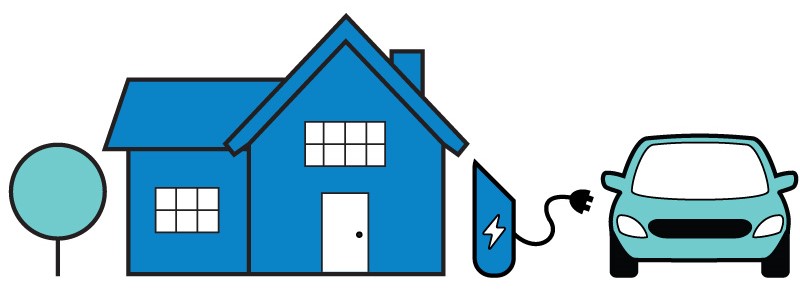
Download a copy of the glossary
Annual Fuel Utilization Efficiency (AFUE):
AFUE is the measurement of the thermal efficiency of combustion equipment such as hot water heaters, furnaces, and boilers. A higher AFUE means a higher efficiency.
Biomass:
Vegetation, sewage, or agricultural waste used as a fuel or energy source.
Blower Door Test:
A test that measures airtightness in homes and small buildings. It can also be used to find the location of major air leaks. The equipment for the test includes: 1) a temporary door covering installed in an outside doorway; 2) fan that forces air into or out of the building; and 3) a pressure measurement instrument called a manometer to measure the pressure difference across the fan and the building envelope.
BUILT GREEN:
Built Green Canada® is a national, industry-driven organization committed to working with builders interested in responsible sustainability practices in the residential building sector. A BUILT GREEN® certified house includes a two-in-one label with both an EnerGuide label and the BUILT GREEN seal. The homes must be built by BUILT GREEN qualified builders.
Carbon Footprint:
The amount of carbon dioxide and other greenhouse gases emitted into the atmosphere from human activities such as the consumption of fossil fuels. In buildings, carbon is typically emitted from heating, cooling, electricity use (if the electricity is generated by fossil fuels), and hot water use.
Certified Energy Advisor (CEA):
A Certified Energy Advisor is an individual who has been trained and is recognized by Natural Resources Canada to conduct EnerGuide energy models for homes as well as air leakage (blower door) tests.
Climate Change Adaptation:
Actions that reduce the negative impacts, or take advantage of positive impacts of a changing climate. With expectations of sudden rainfalls that result in overland flooding, hotter summer temperatures, and increases in high winds and convective storms, it is important that one’s home and yard is prepared for gradual changes and projected weather extremes.
Climate Change Mitigation:
Actions taken to reduce greenhouse gas emissions. Reducing greenhouse gas emissions is expected to slow global temperature increases.
Cogeneration:
A combined heat and power plant uses an engine to generate power while simultaneously using the waste heat for heating purposes. Using the waste heat and creating electricity on-site makes the system more efficient than a traditional boiler paired with grid electricity. The systems are best suited for buildings that have a constant need for heat (otherwise the heat is wasted). Typically this application works better in larger commercial, institutional, or mixed use buildings than single family homes.
Condominium:
A multi-family building in which the suites in the building are individually owned and the owners pay a monthly fee to cover the operating costs of the building.
District Energy:
A district energy system centralizes heating and cooling energy generation and distributes this energy to an entire neighbourhood. District energy systems have traditionally used high temperature boiler plants that distribute high temperature water through insulated steel piping; this heat is then used directly at each building. More recently, lower temperature systems are being used which allow much easier tie-in of renewables and eliminate the need for boiler plants. A district energy system is installed on a community scale and not by single family home.
Drain Water Heat Recovery:
The use of a heat exchanger to recover energy and reuse drain water heat from various activities such as dishwashing, clothes washing, and especially showers. The technology reduces energy consumption for water heating and is also known as water heat recycling, drain-line heat exchange, or grey-water heat recovery.
Ecological Footprint:
A measure of the amount of biologically productive land necessary to supply the resources a human population consumes and to absorb the associated waste.
EnerGuide:
The official Government of Canada mark associated with the labelling and rating of the energy consumption or energy efficiency of specific products. EnerGuide™ labelling exists for appliances, heating and cooling equipment, houses, and vehicles.
Energy Rating (ER) for Windows:
The energy rating (ER) value is calculated using a formula that balances a product’s U-value with its potential solar heat gain coefficient (SHGC) and its airtightness. The higher the number, the more energy-efficient the product. ER values normally range from 0 to 50.
ENERGY STAR:
The international symbol of premium energy efficiency. Products that display the ENERGY STAR® symbol have been tested according to prescribed procedures and have been found to meet or exceed higher energy efficiency levels without compromising performance.
Environmental Product Declaration (EPD):
In life cycle assessment, an EPD is a standardized way of quantifying the environmental impact of a product or system. EPDs are independently verified and communicate transparent information about the life-cycle environmental impact of products. Having an EPD for a product does not imply that the declared product is environmentally superior to alternatives; rather, it is simply a transparent declaration of the life-cycle environmental impact.
Geoexchange:
Low-temperature earth energy commonly used for heating and cooling a building with a heat pump. The stable temperature of the earth just below the surface can be used as a heat source or sink to generate free earth-energy for a building.
Geothermal Energy:
Energy derived from the heat in the interior of the earth.
Greenhouse Effect:
The earth’s atmosphere acts somewhat like the glass of a greenhouse. Some incoming radiation from the sun is reflected directly back to space by the earth’s atmosphere and surface and some is absorbed by the atmosphere. The rest of the incoming radiation is absorbed by the earth’s oceans and land, where it’s converted into heat, warming the surface of the earth and the air above it. Particular gases in the atmosphere act like the glass of a greenhouse, preventing the heat from escaping. Without this natural greenhouse effect, the earth would be much colder—about 33°C colder—making the average temperature on the planet a freezing -18°C rather than the 15°C it is now.
Greenhouse Gases (GHGs):
Any of the gases whose absorption of solar radiation is responsible for the greenhouse effect, including carbon dioxide, methane, ozone, and the fluorocarbons.
Ground-Source Heat Pump (GSHP):
A central heating and/or cooling system that pumps heat to or from the ground. It uses the earth as a heat source in the winter, or a heat sink in the summer. This design takes advantage of the moderate temperatures in the ground to boost efficiency and reduce the operational costs of heating and cooling systems. Also known as a geoexchange system.
Heat Pump:
A heat pump is a mechanical system that extracts heat out of a cold space into a warmer one, such as out of the air or the ground and into a home. Heat pumps can also be used for cooling and typical examples of this are air conditioning units and refrigerators. The relative energy and cost savings for installing a heat pump depends on your heating system and the current cost of energy. By running a heat pump you will use less natural gas, but you will use more electricity to run the pump.
Heat Recovery Ventilator (HRV):
A fully ducted system that delivers fresh-filtered outside air into the house, while moving stale air out. As the fresh air passes the stale air (in separate chambers), the heat from the hot stale air is passed to the cool fresh air, pre-warming it before it is heated. This action reduces the amount of energy it takes to heat the home.
Hydronic Heating:
A heating system that transfers heat by circulating a fluid through a closed system of pipes.
Leadership in Energy and Environmental Design (LEED):
A third-party certification program and an internationally accepted benchmark for the design, construction, and operation of high-performance green buildings, homes, and neighbourhoods. The program is administered in Canada by the Canada Green Building Council (CaGBC).
LEED Canada for Homes:
Leadership in Energy and Environmental Design® (LEED) has several programs for certifying buildings based on building type. LEED Canada for Homes certifies single-family homes, townhomes, and even low-rise multi-family houses up to 3 levels high. Certification requires on-site inspection and third party verification meaning certifications are based on what is actually constructed.
Living Building Challenge (LBC):
LBC™ is one of the most difficult programs to gain certification under as it has the most stringent requirements, including requirements to achieve net zero energy and water. LBC has seven performance categories, or “Petals”, which are further divided into twenty “Imperatives” that can be applied to almost any building type, scale, or location. The Petals include Place, Water, Energy, Health and Happiness, Materials, Equity, and Beauty.
Location Efficiency:
A term that describes how easily you can access work, shopping, entertainment, parks, and other amenities from your home, either by walking or through the use of transit. If the location of your home results in easier walks, shorter car trips, and faster access to transit, it’s generally considered a more efficient location.
Low-Emissivity (Low-E) Coating:
The coating put on glass to reduce its thermal (heat) emissivity (loss). Low-E-coated windows can provide greater thermal efficiency (insulation properties) than regular windows.
Multi-Family Building:
Under the EnerGuide program, a multi-family building is defined as any building that has four or more levels or storeys, and where 50% or more of the floor area is residential.
Native Plants:
Native plants are species indigenous to a certain geographical area, meaning they thrive in that climate. Native plants are relatively unaffected by drought, wind, and extremes in temperature, and are particularly helpful for Edmonton’s short prairie growing season.
Net-Zero Home:
A home that produces at least as much energy on-site from a renewable source as it uses on an annual basis.
On-Demand Hot Water Heater:
On-demand or tankless hot water heaters can be between 19% and 53% more energy-efficient than conventional storage tank water heaters; however they typically cost more to install. The greatest potential improvements are in homes that use the least hot water—typical hot water heaters continually use energy to heat water all day long even when not being used.
Passive Design:
Passive design is key to green building design. It’s an approach that maximizes the use of free, renewable sources of energy such as sun and wind to provide household heating, cooling, ventilation, and lighting. This reduces or removes the need for mechanical heating or cooling. Using passive design can reduce temperature changes, improve indoor air quality, and make a home drier and more enjoyable to live in. (Passive design is also called passive solar design.)
Photovoltaic (PV) Panels:
Specially designed panels that convert solar energy into electricity as an alternative to getting power from the electrical utility grid. Also called solar panels.
R-2000:
Operated by the Natural Resources Canada (NRCan) Office of Energy Efficiency, R-2000 is a voluntary standard for new homes which demands a high level of energy efficiency, typically beyond what building codes require.
Radon:
Radon is an odourless radioactive gas that occurs naturally in the environment and can accumulate within homes. It arises from the breakdown of uranium, which is a common trace element in some natural geologic materials such as granite, shale, or phosphate minerals. Radon has been connected to serious health issues and is the second leading cause of lung cancer in Canada, with 1,900 Canadians dying each year due to exposure to high levels of radon. Radon is present across Canada.
Red List:
Red list chemicals are the chemicals and compounds that are known to have the worst health effects. These chemicals can be found in all products including various building materials. Look for products that do not contain these worst-in-class chemicals and compounds.
RSI:
RSI stands for “R-value Système International,” meaning it measures the R-value of an insulating material, but uses the international metric system of units. Converting one to the other requires some simple math: R-value (US) = RSI multiplied by 5.678263337 or RSI (SI) = R-value multiplied by 0.1761101838.
R-Value (Insulation):
R-value, which stands for "resistance value", provides a means for quantifying the thermal resistance of an insulating material. It is a measure of thermal resistance used in the building and construction industry. Thermal resistance is a measure of a temperature difference by which an object or material resists a heat flow—the higher the R-value, the more effectively the insulation resists the transfer of heat (that is, less heat escapes your home in the winter and less heat enters your home in the summer). If the R-value is low, the material is a poor insulator.
Single-Family Home:
Under the EnerGuide program, a single-family home includes the following building types: fully detached house, duplex, triplex, fourplex, row house, or low-rise multi-family building no more than three storeys high and in which over 50% of the floor area is residential.
Solar Gain:
The increase in temperature in a space, object, or structure that results from solar radiation. The amount of solar gain increases with the strength of the sun and with the ability of any intervening material to transmit or resist the solar rays. This concept is also referred to as solar heat gain or passive solar gain.
Solar Heat Gain Coefficient (SHGC):
The number to know when selecting windows, doors, and skylights. It’s a measure of how much of the sun’s heat is transmitted through those fixtures, expressed in a number from 0 to 1. A window that has a SHGC of 0.3 allows 30% of the sun’s heat to pass through. Whether you want a higher or lower number depends on your goal: a product with a low SHGC helps block heat and reduce cooling loads in hot weather; a product with a high SHGC is more effective at harnessing solar heat in cold weather.
U-Value:
The heat transfer coefficient that describes how well a building element conducts heat. It measures the rate of heat transfer through a building element over a given area under standardized conditions. The usual standard is at a temperature gradient of 24°C, at 50% humidity, with no wind. A smaller U-value is better at reducing heat transfer. A value of 0.33 is a good benchmark for a double-paned, argon-filled window.
Walk Score:
A large-scale, public access walkability index that assigns a numerical walkability score to any address in Canada. The final score gives you a general idea of how walkable your area is by analyzing how close common, everyday amenities like grocery stores, transit stops and shopping malls are to your home.
WaterSense:
WaterSense®, a partnership program developed by the U.S. Environmental Protection Agency, seeks to reduce water usage by offering people a simple way to use less water with water-efficient products, new homes, and services. Products and services that have earned the WaterSense label have been certified to be at least 20% more efficient without sacrificing performance.
Window-To-Wall Ratio:
The proportion of the building facade area that has glass compared to solid wall provides a benchmark of the thermal performance of the building envelope as a whole. Generally, the larger the window area, the more energy that’s required to heat the building.


